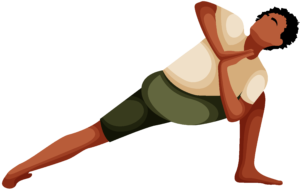Revolved Extended Side Angle (Parivrtta Parsvakonasana)
Pose Overview
| Common Name | Revolved Extended Side Angle |
| Traditional Sanskrit Name | Parivrtta Parsvakonasana |
| Sanskrit Name Pronunciation | pah-ree-VUR-tuh pur-shvah-koh-NAH-suh-nuh |
| Pose Difficulty | Intermediate |
| Drishti
Drishti is the gaze or visual focus point during yoga poses.
Learn more about Drishti |
Over the shoulder |
Revolved Extended Side Angle Pose, also known as Parivrtta Parsvakonasana, is an intermediate level pose that is a combination of two poses: Extended Side Angle Pose and Revolved Triangle Pose.
This pose requires balance, strength, and flexibility, making it a great pose for overall body toning. The pose is said to be named after the moon and the sun, as the pose is said to balance the two opposing forces within the body, much like the moon and the sun balance the night and day.
Benefits of Revolved Extended Side Angle
- Strengthens the legs and core
- Stretches the shoulders, chest, and spine
- Improves balance and stability
- Helps to relieve stress and tension in the neck and shoulders
- Can be therapeutic for those with asthma
How to Enter Revolved Extended Side Angle
- Begin in Warrior II Pose (Virabhadrasana II) with your left foot forward.
- Place your left hand on your left thigh and your right hand on your right thigh.
- As you exhale, twist your torso to the left and place your left elbow on the outside of your left thigh.
- Bring your right hand behind your back and reach for your left ankle, or the inside of your left foot.
- Keep your left knee facing forward and press your left thigh and elbow into each other.
- Look over your left shoulder and hold the pose for several breaths.
How to Exit Revolved Extended Side Angle
- Release your right hand from your left ankle and place it on your right thigh.
- Straighten your left arm and twist to face forward.
- Come back to Warrior II Pose and repeat on the other side.
Common Revolved Extended Side Angle Modifications & Variations
- If reaching for the ankle is difficult, place your hand on a block or the floor for support.
- To deepen the twist, bring your left elbow to the outside of your left knee.
Common Mistakes with Revolved Extended Side Angle
You may find difficulty or discomfort in this pose if you find yourself not twisting from the torso, but twisting from the waist or hips. Some people also struggle because they are not engaging the core or keeping the left knee facing forward.
Safety Guidance
This pose activates a lot of muscles between the stretching, twisting, and balancing that it calls for. Please be mindful of any neck or shoulder injuries before attempting this pose.
Keep the left knee facing forward to avoid any knee injury.
Always be aware of your body and do not push past its limits. It's always best to gradually grow into a pose instead of forcing yourself to do something your body isn't ready for.

